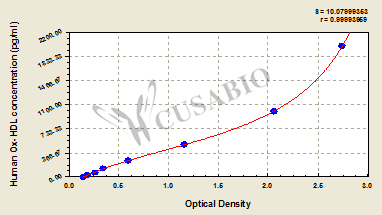Oxidized high density lipoprotein (Ox-HDL) is a modified form of HDL that has undergone oxidative damage, changing its structural and functional properties compared to native HDL. This oxidative modification occurs through several mechanisms including exposure to reactive oxygen species, enzymatic processes, or inflammatory conditions. Ox-HDL has become an important biomarker in cardiovascular research, as it may reflect oxidative stress levels and has been linked to various pathological conditions. Measuring Ox-HDL levels provides valuable insights into lipid metabolism dysfunction and oxidative damage in biological systems.
The Human oxidized high density lipoprotein (Ox-HDL) ELISA Kit (CSB-E16552h) uses a quantitative sandwich measurement principle for detecting Ox-HDL in human samples. This assay works with multiple sample types including serum, plasma, urine, and tissue homogenates, with a detection range spanning 31.25 pg/mL to 2000 pg/mL and a sensitivity of 7.81 pg/mL. The protocol requires 50-100 μL sample volume and can be completed within 1-5 hours, with detection performed at 450 nm wavelength.
Application Examples
Note: The following application examples are drawn from a selection of publications citing this product. For additional applications, please refer to the full list of references in the "Citations" section.
This ELISA kit has been used in research studies investigating oxidative stress and antioxidative capacity in human serum samples. The kit serves as part of comprehensive oxidative marker panels to evaluate the balance between oxidative damage and antioxidant defense mechanisms in various research contexts.
• Oxidative stress research: Measuring oxidized high-density lipoprotein levels alongside other oxidative and antioxidative markers including total antioxidant capacity, carbonyl proteins, and nitrotyrosine in serum samples
• Metabolic biomarker studies: Integration into broader metabolic profiling panels examining lipid metabolism markers and cardiovascular risk factors in intervention studies
• Intervention research: Evaluating oxidative stress markers in controlled studies examining the effects of dietary or lifestyle interventions on metabolic health parameters
• Comprehensive biomarker studies: Application in studies measuring multiple metabolic and oxidative stress indicators to understand relationships between oxidative damage and overall health status






